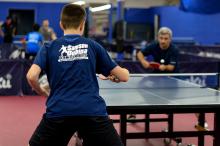Serve Return
About 95% of all players say that serve return is their biggest problem.
#1 Strokes
In order to return very spinny serves, it is vitally important that you know how to stroke the ball with spin so that you can loop, chop, push, or flip the serve. Blocking the serve is rarely ever a good option. By generating your own spin, you won’t feel your opponent’s spin nearly as much. If you block the serve, you will feel the full effect of your opponent’s spin as it has time to “bite” into your rubber. This is the reason that I spend so much time on the basic strokes with younger kids. Once they can understand how to loop, chop, push, and flip, then making small adjustments in the backswing, racket angle, feeling, etc, is simple. Get the strokes right and serve return will become much easier.
#2 Long Serves
When you see a tricky long serve coming (and you have no idea what it is) then wait on a ball before looping or chopping. By waiting, it gives you more time to read the spin, the spin on the ball will slightly decrease, and the speed on the ball will slightly decrease. If you can read the bounce, then you can adjust accordingly. If the ball has slightly less spin, then it will be more manageable. If the ball has less speed, it will allow you to “grab” the ball better, which give you more spin on your loop or chop. When a fast, deep serve comes, most players charge the table and power block it off-the-bounce. I recommend when a long serve comes that you wait, read it, and spin it on deep with good placement.
#3 Short Serves
If the serve is actually short, then you need to step forward and lean over the table. (I use the word “actually” because many serves are assumed to be short but are actually long.) Once you have stepped in for the short serve, your body is now stable. When you are stable, it is much easier to control the flip to a good location or to trick your opponent with a push by dropping short or jamming long. When receiving the short serve with a push, it is critical the contact the ball early on the rise. When receiving the short serve with a flip, it is critical to contact the ball on the top-of-the-bounce. Most players have those two contact points reversed.
#4 Spin
The easiest way to read the spin is to watch your opponent’s racket. Just remember that the direction that the racket is swinging is the direction that the ball will jump off of your racket. If your opponent is swinging down, then it is backspin and the ball will want to jump down off your racket. If your opponent is swinging down and to his right, then it is backspin sidespin and the ball will want to jump down and to his right off your racket. Reading the spin involves four different aspect – watching the racket, listening for the sound, watching the bounce, and looking for the label. Listening for the sounds difference is nearly impossible as most top-level players tap their foot when serving to cover up the sound. If you don’t see a label, it means nothing. If you do see a label on the ball, it means that the serve has no spin or very very little spin. Some top-level player hide the no-spin by turning the label to the side before serving. Just remember that watching the racket and watching the bounce are more reliable than listening for sound or searching for the label.
#5 Practice
At the conclusion of your next practice session, ask your training partner to serve you 30 min of serves. Don’t play the point, just focus on reading the spin, getting in position, and generating your own spin. After 30 min, then do the same for him. If serve return really is your main problem, then it is totally appropriate to isolate just serve return and spend focused time on it each session.
In conclusion, I’m going to re-emphasize my first point. In order to return very spinny serves, it is vitally important that you know how to stroke the ball with spin so that you can loop, chop, push, or flip the serve. By generating your own spin, you won’t feel your opponent’s spin nearly as much. As you continue to perfect this first point, then the other aspects of serve return will become much easier!
Serve Return Training Camp!!!!
August 17-21, 2020
Training Camp - Registration Form
Training Camp – Updated Safely Information
Training Camp – Hotel & Transportation
Training Camp - Videos
Training Camp - Testimonials
Training Camp - Topics for Week 3
Training Camp - Player Listing (August 17-21)
We are limiting the group size - register NOW to reserve your spot!
Yes, we are still accepting more entries for the Ohio Mega Camps! August 17-21!




